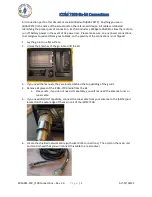
Reference Manual
00809-0100-4835 Rev BE
February 2018
Rosemount 3150 Series
Calibration
42
Figure 3-11b – Example 2 for High Static Line
Pressure Span Correction using Method 2
(SI Units)
Range 5 for a calibration of –1,72 to 5,17 MPa corrected
for 10,34 MPa static line pressure
1. Calculate the corrected LRV pressure input
= -1,72 MPa – ((0,0125 X -1,72 MPa) X (10,34
MPa/6,90 MPa))
= -1,69 MPa
2. Calculate the corrected URV pressure input
= 5,17 MPa – ((0,0125 X 5,17 MPa) X (10,34
MPa/6,90 MPa))
= 5,07 MPa
3. At atmospheric static line pressure, apply 1,69 MPa to
the low side process connection (-1,69 MPa) and
adjust the zero until the transmitter output reads 4 mA.
4. Remaining at atmospheric static line pressure, apply
5,07 MPa to the high side process connection and
adjust the span until the transmitter output reads 20
mA.
5. Check to assure desired outputs are achieved and
repeat steps 3 and 4 if necessary.
When the transmitter is exposed to 10,34 MPa static line
pressure, within specified uncertainties, the output will be 4
mA at -1,72 MPa and 20 mA at 5,17 MPa.
High Static Line Pressure Zero
Correction for DP Transmitters (All
Ranges)
Zero shift with static pressure is not systematic. However, the
effect can be eliminated during calibration. To trim out the
zero error at high static line pressure, perform the following:
•
If the calibrated range includes zero differential
pressure (zero-based or zero crossing):
a. Calibrate the pressure transmitter according to
the preceding sections.
b. Apply atmospheric line pressure to high and
low sides (zero differential pressure).
c. Record the output reading.
d. Apply the intended line pressure to high and
low sides (zero differential pressure).
e. Adjust the zero to match the reading obtained
in step c.
•
If the calibrated range does not include zero
differential pressure (certain zero elevated or zero
suppressed calibrations):
a. Calibrate the pressure transmitter to the
intended span using the
b. Apply atmospheric line pressure to high and
low sides (zero differential pressure).
c. Record the output reading.
















































